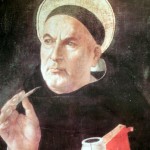How can one be called a “Dumb Ox” and go on to become one of the greatest theologians of all Christianity and a Doctor of the Catholic Church? His colleagues chided him as a student due to his humble demeanor and large physical size. I wonder if his feelings were hurt and what sort of bullying was allowed at his institution of higher education back in the 1200s? I have never heard any stories of St. Thomas of Aquinas sulking from what could be considered a deep emotional wound. His humility indeed may have been an indication of his great sanctity.
St. Thomas Aquinas is one of my favorite saints. First, because he was smart. Second, that in addition to all of his scholasticism he was a mystic. Third, that he was Italian and lived not far from a place of my ancestry. And fourth– I’ll go ahead and say it –because he was fat. It is a relief to hear that some physically large persons have been canonized. That would make him a patron for persons who struggle with their weight. Perhaps I don’t have to dwell on the battle of bulge as much as I do.
St. Thomas, whose feast day is January 28, is known to be the Angelic Doctor of the Church. He was a Dominican priest and medieval theologian. One of his most famous works, the Summa Theologica, is considered a pinnacle of scholasticism. In it he tries to systematically draw conclusions from Aristotle premises that pertain to the metaphysics of personality, creation, and Providence. In other words, he tries to explain the question, “What is God?”
His work is quite extensive and can either be fascinating to those intellectually inclined or pure frustration to those who are less mentally endowed. For me, I have to read his stuff very slowly and digest each sentence over a lengthy period of time. Let’s just say, I have not gotten very far. It is not a work for speed reading.
Yet in all of his knowledge and great scholasticism, St. Thomas of Aquinas was not satisfied. His work was not finished. He grew frustrated in his attempt to explain “What is God” and threw his work aside after a vision. I have heard that his masterpiece was actually retrieved from the trash but have not been able to verify this. He described his own Summa, “Straw in the wind compared to the reality of divine glory.” Four months later he died.
Even the smartest among us cannot explain God. In a prayer St. Thomas states: Grant me, O Lord my God, a mind to know you, a heart to seek you, wisdom to find you, conduct pleasing to you, faithful perseverance in waiting for you, and a hope of finally embracing you.
In summary St. Thomas realized that reason alone cannot explain all there is to the mystical quality of the soul knowing and loving God. While we can try to explain God, there is more to the Sacred Mysteries of our Church and faith beyond human comprehension.
One great example I often encounter is when persons try to intellectually explain transubstantiation in the Eucharist. People try to put the Eucharist through the scientific method. Although there are miracles that back-up that the bread and wine are really the Body and Blood of Jesus, mostly we operate by faith in embracing this Sacred Truth. This is why it is called a Sacred Mystery. Another common example I often encounter is people making an effort to explain God or “explain away Jesus” by trying to find His written record in historical books other than the Bible and the writings of the Saints. This is a futile effort when the back bone of the Church is built upon Tradition. The fact that the Church exists and is built upon blood of the martyrs is the testament that He actually existed. Not to mention that even our current date centers around the fact that Jesus was born. These are things that are actually resented by some non-believers. The opportunity of faith for some becomes the item of contention for others. But this is a topic that could be addressed more in-depth in another post.
Believing is an act of the intellect assenting to the divine truth by command of the will moved by God through grace. – St. Thomas Aquinas

